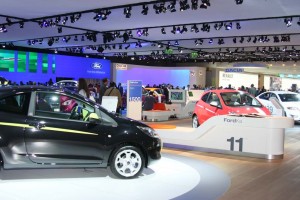
See the Blue Oval? If not, no surprise, like its cross-town rivals, Ford's presence at the 2009 Frankfurt Motor Show was minimal.
It’s hard to find an inch of unused space at the grand Festhalle pavilion that Mercedes-Benz has filled with its newest products and displays touting its latest technology. Nor is there any more room left at Halle 11, the newest addition to the Messe, the convention center, where BMW has set up shop for the 2009 Frankfurt Motor Show.
But try to find General Motors’ Chevrolet brand, and you’ll have to turn down a side alley off one of the lesser pavilions, where the division has been parked in a small tent.
The situation isn’t much better for Chrysler, which abandoned its traditional auto show display, settling instead for a corner of the stand set up by Fiat, the Italian automaker that has taken control of the struggling U.S. automaker.
Even Ford Motor Co., generally considered the healthiest of Detroit’s Big Three, and one of the top brands in Europe, isn’t much more visible.

Opel CEO Carl-Peter Forster unveils the Ampera concept vehicle. The GM decision still had a fair-sized presence at the 2009 Frankfurt Motor Show, but GM is selling a controlling stake in the German maker. The Chevy brand was relegated to a tent outside.
Ford once took the upper floor of the cavernous Halle 3 – the bottom floor filled by the Continent’s largest maker, Volkswagen, and its various divisions. Two years ago, Ford’s display was nearly as big as VW’s, the U.S. maker dividing the second floor up with its own subsidiaries, Volvo, Land Rover, Jaguar, Aston Martin, and Japanese affiliate Mazda.
But this time around, after ditching most of those brands, Ford is neatly tucked in a corner booth of less than 5,000 square feet – no bigger than the adjacent displays operated by such European market also-rans as Suzuki, Kia and Dacia. Dacia?
“We have a pretty strong presence,” contends Ford spokesman Don Hume, “and we can demonstrate our full product range pretty comfortably.”
Now, German makers have traditionally staged the largest and most lavish displays at the Frankfurt Motor Show, no surprise since this is considered their “home” show and the obvious place to plant their flags. The other big European event, the annual spring Geneva Motor Show, is considered neutral territory, and displays are traditionally more balanced among big brands.
But even by traditional Frankfurt Motor Show standards, Detroit’s Big Three have all but gone into hiding. Why?
“Cost is obviously a factor,” says Hume.
By some estimates, BMW has invested perhaps $30 million or more in Halle 11, where it has even constructed a circular indoor track to show off its newest products in motion. Ford has normally not been afraid to make a big investment in its stands. A decade ago, it convinced organizers of the Geneva show to permit it to cut into the PALExpo convention center’s superstructure to permit it to set up an oversized stand.
But the Detroit makers – even Ford – are clutching their purse strings tighter than ever, these days, in the wake of the GM and Chrysler bankruptcies. And though GM actually does have a bit bigger presence than Chevy alone, it last week agreed to sell off its German-based Opel subsidiary, which shares Halle 8 with major competitors such as Toyota and Peugeot.
“They’re definitely making a big mistake not investing in this show,” said a senior industry analyst who asked not to be directly quoted criticizing the Big Three. “They should be reinforcing their image, right now, but instead, they’re taking a critical drubbing,” among the attending media for seeming to surrender, he argued.
Whether the Detroit makers will expand their presence at upcoming European shows, or continue to scale back remains to be seen. Even in the U.S., they’ve generally been trimming costs, as well. At last November’s Los Angeles Auto Show, Chrysler actually turned off many of the lights on its stands, reflecting the worsening cash crisis that ultimately forced it into bankruptcy.
There are those who debate the value of auto shows, in general, and more than a few foreign makers have been scaling back their presence at the annual Detroit Auto Show, arguing that it is becoming less significant as a way to sell cars. But Frankfurt is a definite showcase, and the fact that Detroit is pulling back, said several industry observers, isn’t likely to build confidence among the customers the Big Three need to re-build their brands.

The Japanese makers didn’t have much presence in Frankfurt either, did they?
Sure, they’re not recovering from bankruptcy and trying to turn some public sentiment around, but still, wasn’t the presence of Honda, Daihatsu, Suzuki, Nissan, and Mitsubishi all small as well?
None had major announcements, did they?
Stephanie: You’re right about the Japanese companies, which for the most part have not been as successful in Europe as they have been elsewhere in the world. However, Ford is number two in European sales in the 19 major markets, a position that GM’s Opel used to compete for. (Nissan’s big announcement was made by its Alliance partner Renault. If it too prices Nissan versions of electric cars at the same level Renault claims it will, then it would be a major breakthrough.)